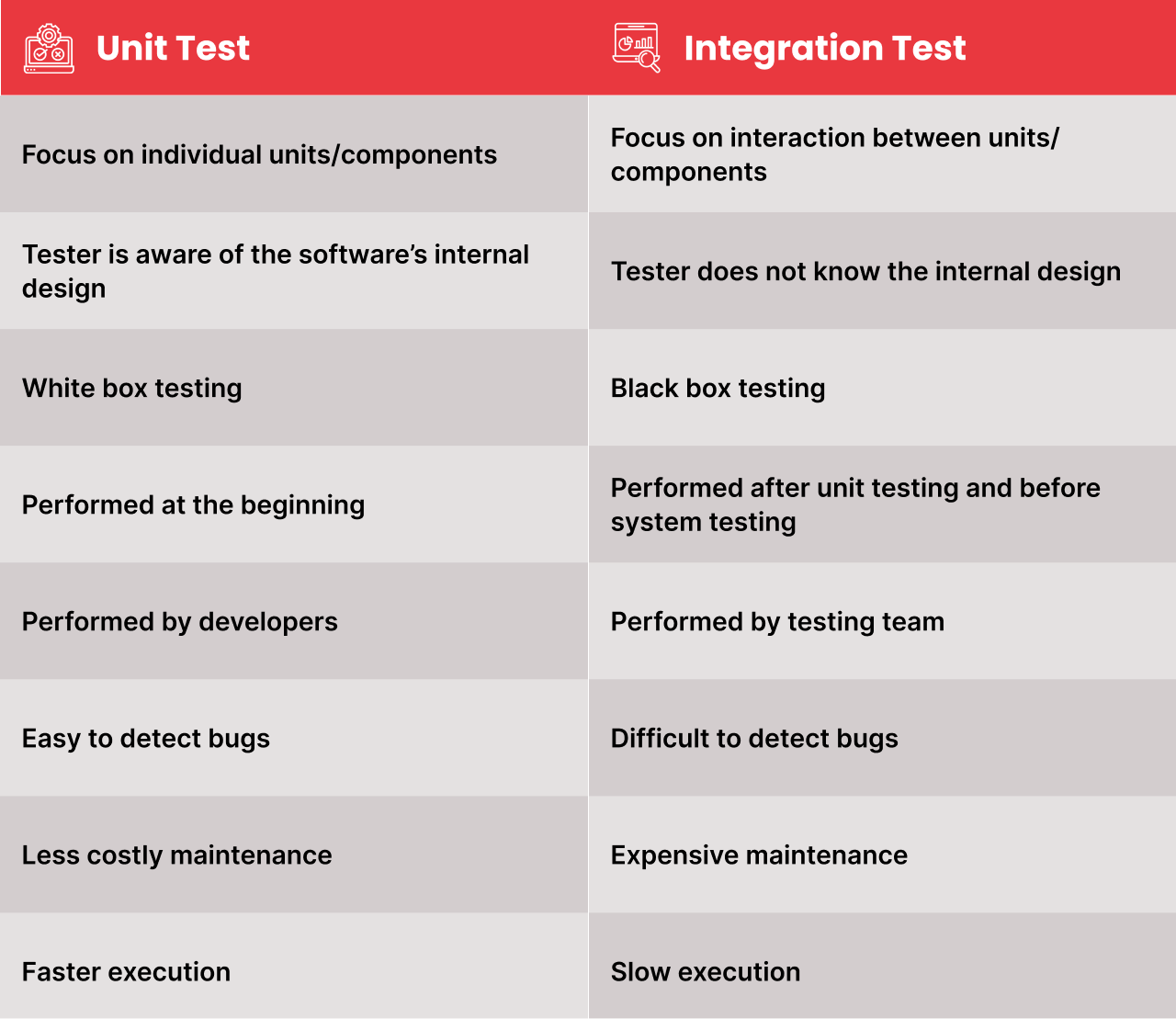Unit testing and integration testing play crucial roles in the software development life cycle, serving different purposes. While they both focus on testing software components, they operate at different levels of granularity. As a result, unit test vs integration test comparison is frequently made even though these two testing approaches form the foundation of the testing pyramid, demonstrating their significance.
In this blog post, we will understand these software testing types and explore the areas which serve as a ground for comparing the two.

What is Unit Testing?
Unit Testing is a software testing technique that involves testing individual components or units of code in isolation. The goal is to ensure that each component of the software performs as intended and meets the specified requirements. Typically, this type of testing is performed by developers during the development phase of the software lifecycle and can be automated using testing frameworks.
Benefits of Unit Testing
Early Bug Detection: Unit testing helps identify bugs and issues in individual units of code early in the development process. By catching problems at an early stage, developers can address them promptly, preventing the bugs from proliferating into more complex issues later on.
Code Quality and Maintainability: It encourages developers to write modular and loosely coupled code. When each unit of code is tested independently, it promotes code modularity, reusability, and maintainability. Unit testing also acts as a safety net during code refactoring, ensuring that changes do not introduce unintended side effects.
Faster Debugging and Troubleshooting: When a unit test fails, it pinpoints the specific unit or component that is causing the issue. This focused approach makes debugging and troubleshooting faster and more efficient, as developers can isolate the problematic area without having to examine the entire system.
Documentation and Code Understanding: This type of software testing serves as executable documentation for the codebase. They provide examples of how to use and interact with each unit of code, which aids in code understanding for both current and future developers working on the project.
Regression Testing and Continuous Integration: Unit tests can be automated and integrated into a continuous integration (CI) process thus allowing for regular execution of tests whenever changes are made to the codebase. By running unit tests automatically and frequently, developers can quickly identify if any modifications introduced unintended consequences or regressions.
Collaboration and Team Confidence: Collaboration among team members. Developers can share and review each other’s unit tests, fostering knowledge sharing and ensuring code quality are the other benefits of unit testing. Additionally, having a comprehensive suite of passing unit tests gives the team confidence in the stability and reliability of the codebase.
Cost and Time Savings: While writing unit tests requires an upfront investment of time and effort, they can result in long-term cost and time savings. Unit tests help catch bugs early, reducing the need for extensive manual testing and costly bug fixes in later stages of the development cycle.
What is Integration Testing?
Unlike unit testing, integration testing focuses on multiple units or components of software to ensure that they function correctly as a whole. Rather than a developer, there is a dedicated testing team or quality assurance team who performs this type of testing.
Benefits of Integration Testing
Identifying Integration Issues: By simulating real-world scenarios and testing the coordination between different units, integration testing unveils issues like incompatible interfaces, data inconsistencies, or communication failures. Detecting and resolving these issues early ensures a smoother integration process and prevents them from escalating into more critical problems.
Improved System Performance: Through integration testing, QA teams can assess the overall performance of the integrated system and identify bottlenecks, performance degradation, or resource conflicts that may emerge when components interact.
Enhanced Functionality and User Experience: Integration testing guarantees that the system functions as expected by verifying the seamless flow of data and operations between modules. ensures that all integrated components work harmoniously to deliver the intended functionality. Additionally, testers can identify functionality gaps, missing features, or inconsistencies in the user experience through this type of testing thus enhancing the overall usability and satisfaction of end-users.
Increased Reliability and Stability: There may be some hidden defects in software that may surface only when components are integrated. Integration testing can uncover those defects by simulating real-world usage scenarios and validating the stability and reliability of the software system as a whole. As a result, the likelihood of system failures and downtime can be reduced to a vast extent.
Seamless Third-Party Integration: If the software is meant to be integrated with external systems, performing integration testing is a savior as it helps in verifying the compatibility between the two. So that, any compatibility issues or data inconsistencies can be detected on an early basis and risks can be minimized. This is important to promote operability.
Unit Testing vs. Integration Testing: The Key Comparison Features
As aforementioned that both serve different purposes, they are complementary and essential for overall software quality. Below are a few comparisons features that differentiate unit tests to integration tests.
Scope:
- Unit testing focuses on testing individual units or components in isolation.
- Integration testing tests the interactions and interfaces between multiple units or components.
Objectives:
- Unit testing primarily aims to ensure the correctness of individual units and validate their behavior.
- Integration testing focuses on verifying that the integrated system functions correctly as a whole and that the components work together seamlessly.
Specifications:
- The specifications of unit testing are written by the developers and are usually low-level tests that ensure the correct behavior of individual functions or methods.
- The specifications of integration testing are written by the testers and are usually higher-level tests that ensure the correct behavior of the system as a whole.
Granularity:
- Unit testing operates at a finer level of granularity, testing small units of code, such as functions or classes.
- Integration testing operates at a higher level, testing the interaction between larger components or subsystems.
Dependencies:
- Unit testing aims to isolate units from their dependencies by using test doubles (e.g., mock objects or stubs).
- Integration testing, on the other hand, focuses on testing the integration points and dependencies between components.
Execution:
- Unit tests are typically executed frequently during the development process, often automated and run by developers themselves.
- Integration tests are usually performed later in the development cycle when multiple components are ready for integration.
Automated or manual:
- Unit testing is typically automated, and developers use testing frameworks to write and run unit tests. It is a fast and efficient way of testing, and it allows developers to catch and fix bugs early in the development cycle.
- Integration testing can be both automated and manual. It is usually more complex and time-consuming than unit testing, and it requires a test plan, test cases, test data and a test environment.
Type of software testing:
- Unit testing is a type of white-box testing, where the tester has knowledge of the internal structure of the software and its working.
- Integration testing is a type of black box testing because tester has nothing to do with the software’s internal design and working.
Time and Resources:
- Unit Testing is generally faster and easier to perform than Integration Testing since it involves testing individual components of the code in isolation.
- Integration Testing, on the other hand, requires more time and resources to test the interactions between different components of the software.
Maintenance and Debugging:
- Unit Testing helps to make code more modular and easier to maintain. When a defect is found in Unit Testing, it’s relatively easy to locate and fix since the defect is isolated to a specific component.
- Integration Testing, on the other hand, can be more challenging to debug since defects may arise due to interactions between different components of the software.
A Glance: Difference Between Unit Testing and Integration Testing

Conclusion
Software testing plays a critical role in evaluating the effectiveness of the software. Among the initial steps in this process, unit testing and integration testing are essential for maintaining software quality, identifying bugs, and ensuring the proper functionality of all components.
However, relying solely on these individual testing methods does not guarantee desired outcomes. Instead of comparing and choosing between unit testing and integration testing, a coordinated approach should be embraced to achieve superior results and deliver high-quality software products to the market.



